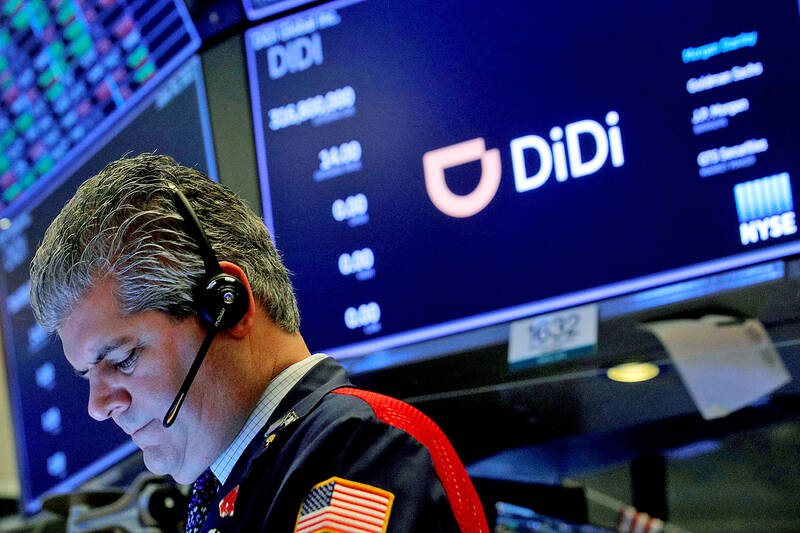Chinese authorities are set to allow Didi Global Inc’s (滴滴) ride-hailing and other apps back on domestic app stores as soon as next week, five sources said, in yet another signal that their two-year regulatory crackdown on the technology sector is ending.
Didi has been awaiting authorities’ approval to resume new user registrations and downloads of its 25 banned apps in China as a key step to resume normal business since its regulatory troubles started in the middle of 2021.
The lifting of the new user ban and app resumption for its flagship ride-hailing services and other businesses could take place before the Lunar New Year holiday, which starts next week, four of the sources said.

Photo: REUTERS
The one-week holiday would help Didi start to attract new users for the business and work toward bringing it back to normal, two of the sources added.
A lifting of the ban on Didi apps would come as Chinese policymakers seek to restore private-sector confidence and count on the technology industry to help spur economic activity that has been ravaged by the COVID-19 pandemic.
The People’s Bank of China is to step up support for private firms as part of steps to shore up the economy, while easing a crackdown on tech companies, Chinese Banking and Insurance Regulatory Commission Chairman Guo Shuqing (郭樹清) said on Sunday.
A restoration of apps would also signal Didi’s completion of a regulatory-driven revamp, and would come after the Chinese Cyberspace Administration in July last year imposed a US$1.2 billion fine on the company.
Two sources said that Didi paid the fine, the largest regulatory penalty imposed on a Chinese tech firm since Alibaba Group Holding Ltd (阿里巴巴) and Meituan (美團) were in 2021 fined US$2.75 billion and US$527 million respectively by the Chinese State Administration for Market Regulation.
The penalty on Didi was part of Beijing’s sweeping and unprecedented crackdown on the country’s technology titans over the past two years, which has sliced hundreds of billions of dollars off their values and shrunk revenues and profits.
Chinese regulators, led by the Cyberspace Administration, have in the past few weeks restarted to push forward with Didi’s app resumption approval process, two of the sources and another source with knowledge of the matter said.
The regulators, which last week submitted a report on the matter to top Chinese Communist Party leaders, look to formally get their nod in the next few days, two of them added.
Didi, launched in Beijing in 2012 and backed by prominent investors including Alibaba, Tencent (騰訊) and Softbank Group Corp, ran afoul of regulators when it in 2021 pressed ahead with a planned US stock listing against the regulators’ will, sources said previously.
That move triggered regulatory woes for Didi, with its 25 mobile apps ordered to be taken down from app stores, registration of new users suspended and it getting slapped with the fine over data-security breaches.
Didi was also forced to end its 11-month journey as a New York Stock Exchange-traded company in June last year, turning it from a poster child of China’s Internet boom to one of the biggest casualties of Beijing’s regulatory crackdown.

SEEKING CLARITY: Washington should not adopt measures that create uncertainties for ‘existing semiconductor investments,’ TSMC said referring to its US$165 billion in the US Taiwan Semiconductor Manufacturing Co (TSMC, 台積電) told the US that any future tariffs on Taiwanese semiconductors could reduce demand for chips and derail its pledge to increase its investment in Arizona. “New import restrictions could jeopardize current US leadership in the competitive technology industry and create uncertainties for many committed semiconductor capital projects in the US, including TSMC Arizona’s significant investment plan in Phoenix,” the chipmaker wrote in a letter to the US Department of Commerce. TSMC issued the warning in response to a solicitation for comments by the department on a possible tariff on semiconductor imports by US President Donald Trump’s

The government has launched a three-pronged strategy to attract local and international talent, aiming to position Taiwan as a new global hub following Nvidia Corp’s announcement that it has chosen Taipei as the site of its Taiwan headquarters. Nvidia cofounder and CEO Jensen Huang (黃仁勳) on Monday last week announced during his keynote speech at the Computex trade show in Taipei that the Nvidia Constellation, the company’s planned Taiwan headquarters, would be located in the Beitou-Shilin Technology Park (北投士林科技園區) in Taipei. Huang’s decision to establish a base in Taiwan is “primarily due to Taiwan’s talent pool and its strength in the semiconductor

An earnings report from semiconductor giant and artificial intelligence (AI) bellwether Nvidia Corp takes center stage for Wall Street this week, as stocks hit a speed bump of worries over US federal deficits driving up Treasury yields. US equities pulled back last week after a torrid rally, as investors turned their attention to tax and spending legislation poised to swell the US government’s US$36 trillion in debt. Long-dated US Treasury yields rose amid the fiscal worries, with the 30-year yield topping 5 percent and hitting its highest level since late 2023. Stocks were dealt another blow on Friday when US President Donald

UNCERTAINTY: Investors remain worried that trade negotiations with Washington could go poorly, given Trump’s inconsistency on tariffs in his second term, experts said The consumer confidence index this month fell for a ninth consecutive month to its lowest level in 13 months, as global trade uncertainties and tariff risks cloud Taiwan’s economic outlook, a survey released yesterday by National Central University found. The biggest decline came from the timing for stock investments, which plunged 11.82 points to 26.82, underscoring bleak investor confidence, it said. “Although the TAIEX reclaimed the 21,000-point mark after the US and China agreed to bury the hatchet for 90 days, investors remain worried that the situation would turn sour later,” said Dachrahn Wu (吳大任), director of the university’s Research Center for